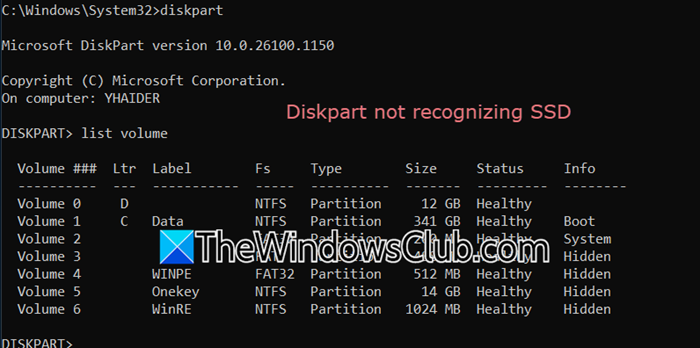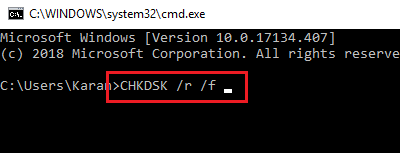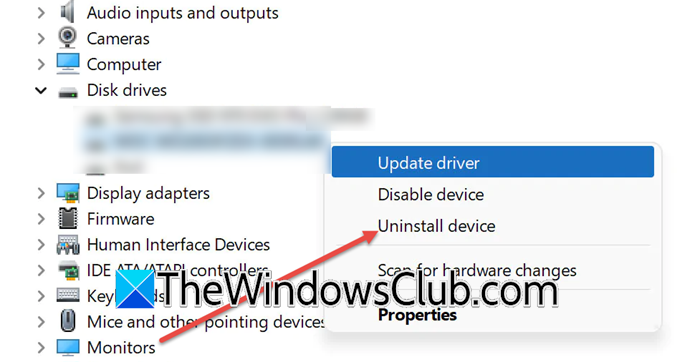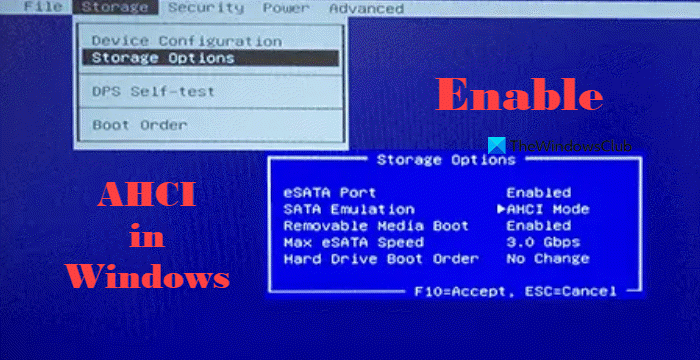Diskpart is a utility that can be used to manage your disks, however, as of late, we have noticed that it is not able to recognize newly added SSDs or HDDs. We can see the model number and everything in the BIOS but when invoking Diskpart, the device is absent. So, in this post, we are going to see what you can do if the Diskpart is not recognizing SSD.

Diskpart not recognizing SSD in Windows 11/10
If Diskpart is not recognizing SSD, try plugging your device into a different computer and see if that helps. In case, that didn’t work, you can follow the steps mentioned below.
- Unplug and replug the device
- Try a new SATA cable
- Check the disk health
- Uninstall the driver and then install it back
- Set SATA Mode to AHCI
- Reset your BIOS
Let us talk about them in detail.
1] Unplug and replug the device
First and foremost, we are going to unplug the SSD device from the computer and then plug it back in. At times this might feel a bit redundant but there is a possibility that due to a glitch, only your BIOS is able to recognize the SSD not diskpart. If you have installed an integrated SSD and are not well-versed when dealing with hardware, consult an expert on how to remove the device and plug it back.
2] Try a new SATA cable
You can also buy a new SATA cable and connect your device with it. If you are not sure if the cable is at fault, borrow it from somebody before spending money on it. If changing the cable doesn’t resolve the issue, move on to the next solution.
3] Check the disk health

Next up, you need to check the disk health and see if the Check Disk command can detect some issues and resolve them. In order to do this, you need a working computer, so, if you can’t boot up your machine, get hold of your friend’s machine to run these commands. Once you have that, follow the steps mentioned below to do the same.
- First of all, you need to boot your computer using the Installation Media.
- Now, go to Repair your computer > Troubleshoot > Advanced options.
- You then have to select the Command Prompt.
- Finally, run the following command.
Chkdsk /r /f
Let it scan your drive and repair it. Once done, your issue will be resolved.
4] Uninstall the driver and then install it back

If you can boot into Windows and the device is visible in Device Manager, but the diskpart is able to figure it out, try uninstalling the device and then installing it back. To do so, follow the steps mentioned below.
- Unplug the new SSD.
- Open the Device Manager.
- Expand Disk drives, right-click on the device, and then select Uninstall device.
- Now, select Uninstall again to confirm your decision.
- Then, plug the device back on and see if the device is installed properly.
- If the device is not installed in the Device Manager, right-click on Disk drives, and select Scan for hardware changes.
Finally, open Diskpart and check if the new drive is being detected.
5] Set SATA Mode to AHCI

Next up, we need to check the SATA mode in the BIOS and make sure that it is set to AHCI. AHCI (Advanced Host Controller Interface) mode is a hardware mechanism that allows software to communicate with Serial ATA (SATA) devices, such as hard drives and SSDs. There is a possibility that the SATA mode is set to RAID, hence, you are unable to see the drive in Diskpart. To resolve this issue, you need to follow the steps mentioned below.
- Boot into BIOS.
- Now, look for SATA Configuration or Storage Configuration, it might be under Main, Advanced, or Boot tab.
- You then have to set the SATA controller mode to AHCI.
- Check that the SATA port to which your SSD is connected is enabled. Sometimes, certain SATA ports might be disabled in the BIOS.
- Finally, save and exit.
Once done, check if the issue is resolved.
Read: How to enable AHCI in Windows after Installation
6] Reset your BIOS
If nothing works, our last resort is to reset the BIOS and see if that helps.
We hope that will be able to resolve your issue using the solutions mentioned in this post.
Read: NVMe SSD not detected in Windows
Why is my new SSD not being detected?
If your new SSD isn’t being detected, try checking the connections, initializing the SSD in Disk Management, updating drivers, ensuring the SATA mode in BIOS is set to AHCI, and trying a different port or cable. You can also run the hardware troubleshooter, check disk health using the Check Disk command, and reset the BIOS if necessary. If these steps don’t work, the SSD might be faulty, and you may need to contact the manufacturer for assistance.
Read: The operation timed out, Diskpart Virtual Disk Service error
How do I fix an undetected SSD?
If your SSD is not being detected, try connecting it to a different system and see if it helps. Additionally, you should check your SATA cable, if it has malfunctioned, SSD will fail to work.
Read: DISKPART Request could not be performed because of IO device error.